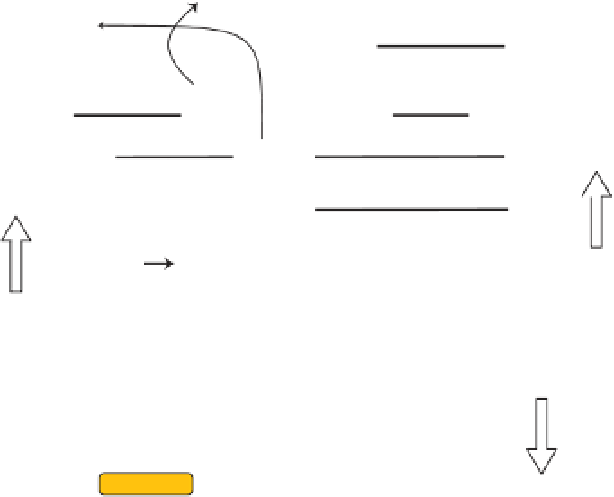Geoscience Reference
In-Depth Information
well as Cl
-
channels in a cDNA library from the gills
of
Z. viviparus
selected for genes upregulated after 24
h of hypercapnia. Furthermore, three differentially
expressed ESTs (expressed sequence tags) of carbonic
anhydrase were identii ed ( Deigweiher 2009 ). Car-
bonic anhydrase is a highly conserved enzyme that
catalyzes the reversible hydration of CO
2
, and thus
enhances the rate at which acid-base equilibria are
reached. The apparent adjustment of carbonic anhy-
drase through individually expressed isoforms
emphasizes its importance in facilitating ion
exchange. The diverse responses of primary and sec-
ondary transporters led to an extension of the pro-
posed model of ion transport regulation (Fig. 8.2).
environment
fish gill epithelium
blood
Na
+
Na
+
K
+
channel
Na
+
Na
+
channel
ATP
+
+
K
+
2 K
+
+
NKA
3 Na
+
HA
ATP
-
=
+
Na
+
Na
+
NHE
2/3
NHE
1
H
+
H
+
H
+
+
+
CA
-
+
HCO
3
HCO
3
-
N
B
C
1
CO
2
CO
2
Na
+
+
H
2
O
Na
+
-
=
N
K
C
C
HCO
3
K
+
AE1
Cl
-
Cl
-
2 Cl
-
+
Cl
-
-channel
Net H
+
extrusion
H
+
Figure 8.2
Working model for ion transport regulation in marine teleosts under hypercapnia (modii ed after Deigweiher et al . 2008 , based on Claiborne
et al. 2002 ; Evans et al. 2005). The model summarizes results from different mRNA and protein studies in common eelpout (Deigweiher et al. 2008 ;
Deigweiher 2009). Red circles indicate the response of gene expression during short-term exposure (24 to 96 h) while green circles indicate the long-term
(about 6 weeks) response to environmental hypercapnia. After diffusive entry CO
2
is hydrated by carbonic anhydrase (CA) producing HCO
3
-
and H
+
. Acute pH
compensation is achieved by non-bicarbonate buffering together with net H
+
extrusion to the water supported by the transitional down-regulation of the
basolateral Na
+
/H
+
exchanger (NHE1) and Na
+
/HCO
3
-
cotransporter (NBC1) and the up-regulation of apical NHE2. Na
+
/K
+
-ATPase (NKA) expression is
up-regulated. A delayed down-regulation of apical Cl
-
/HCO
3
-
anion exchanger (AE1) supports the maintenance of higher bicarbonate levels in the cell and
plasma when extracellular pH is already restored. During long-term compensation, the net accumulation of extracellular HCO
3
-
occurs via an increase in the
abundance of basolateral NBC1 and the maintenance of AE1 and NHE1 at control levels. Net decrease of Cl
-
in blood may be mediated by a basolateral
Na
+
/K
+
/2Cl
-
co-transporter (NKCC) and an apical Cl
-
channel which is up-regulated during short-term exposure. NHE1 is operating at control levels under
long-term steady-state conditions. Net proton extrusion is possibly achieved by apical NHE2/3. The driving force for the new steady state is provided by
elevated Na
+
/K
+
-ATPase density in the basolateral membrane. Excess Na
+
can diffuse via leaky tight junctions into the surrounding water. The mRNA levels of
the respective transporters are depicted as up-regulated (
+
), down-regulated (
-
) or unchanged (
=
). Abbreviations of enzymes: HA, H
+
-ATPase; NHE1/2/3,
Na
+
/H
+
exchanger isoforms; CA, carbonic anhydrase; AE1, Cl
-
/HCO
3
-
exchanger; NKA, Na
+
/K
+
-ATPase; NBC1, Na
+
/HCO
3
-
co-transporter; NKCC, Na
+
/K
+
/2Cl
-
co-transporter. Hollow arrows indicate changes in concentrations.









































